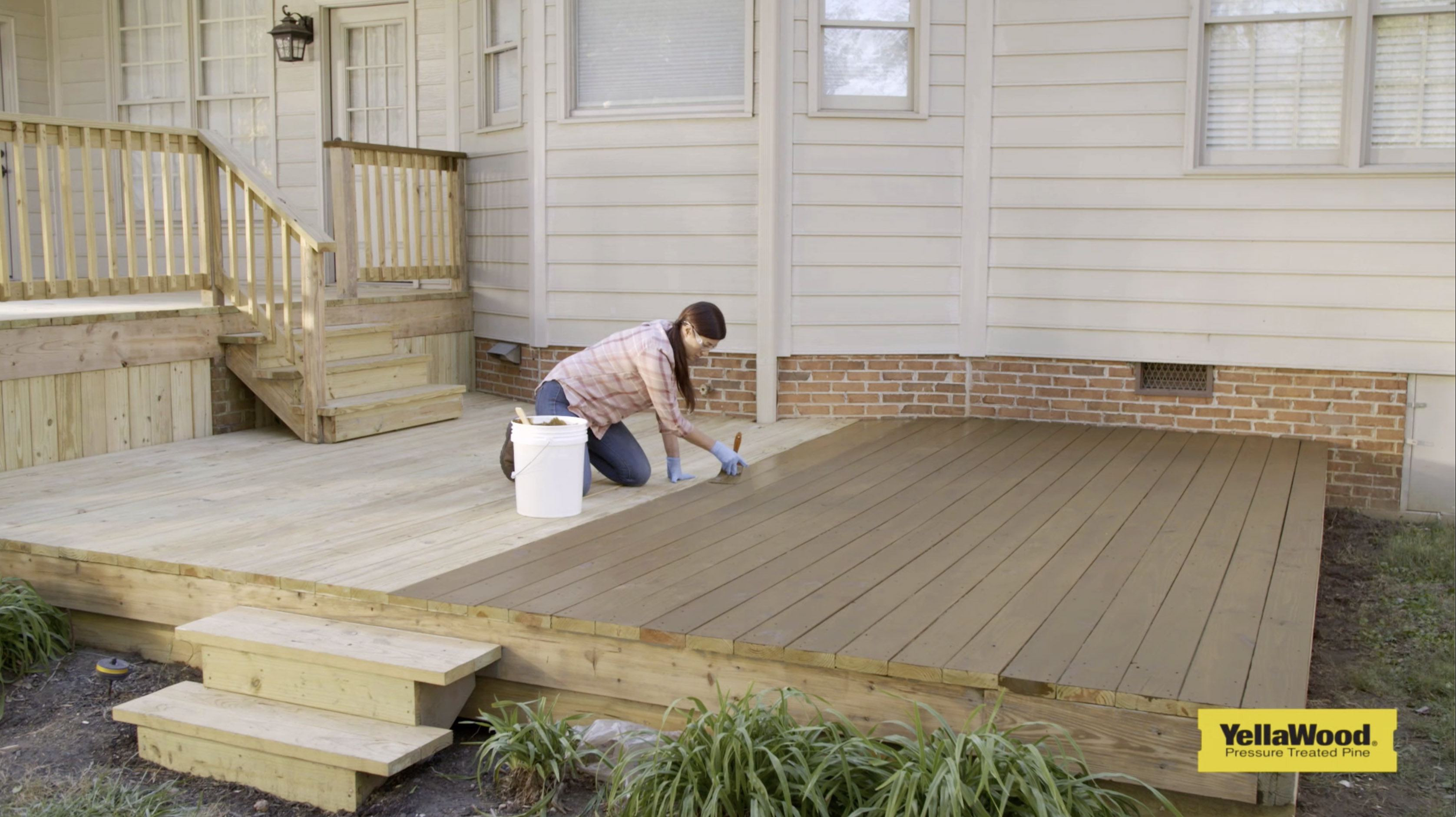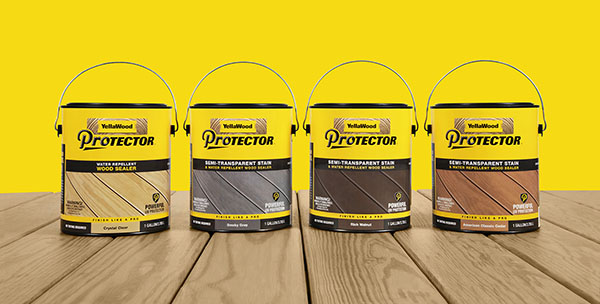YELLAWOOD PROTECTOR® DECK STAIN & SEALER FAQs
It takes a whole lot to earn the Yella tag.
We don’t just put our name on anything. Backed by fifty years of proven knowledge and quality, YellaWood Protector® products are specifically formulated by the makers of YellaWood® brand pressure treated pine.
What is the Guarantee/Warranty?
The YellaWood® brand guarantees satisfaction with this product if it is correctly applied to a properly prepared surface in accordance with label instructions. We warrant the product to resist chipping, peeling, water damage, mold and mildew growth, and color fade.
What Makes YellaWood Protector® Special, Compared to other Stain Brands?
YellaWood Protector® semi-transparent stain and clear water repellent features are a hybrid formula that combines the superior penetration of alkyd oil ingredients with an exceptional acrylic component to provide surface protection. This chemistry makes the product easy to apply and get professional results, as well as being easy to maintain .
Can YellaWood Protector® Products Be Used on Other Types of Wood Besides YellaWood® Brand Pressure Treated Products?
YellaWood Protector® products were designed specifically to work with the more challenging surface presented by pressure treated Southern Yellow Pine. The resulting formula makes YellaWood Protector® products perform exceptionally well on virtually any species of softwood, including spruce, fir, hemlock and cedar.
Can YellaWood Protector® Products Be Used on Other Surfaces Besides Decks?
YellaWood Protector® products are formulated to stand up to the exceptional challenges for deck stains, including direct sunlight and weather exposure, standing water, foot traffic, furniture movement , dirt and grime abrasion . This makes YellaWood Protector® products an exceptional choice of stain for virtually any outdoor surface including fences, siding, outdoor furniture, trellises, pergolas, etc.
Can YellaWood Protector® Products Go Over Previously Stained Surfaces?
Yes, it may go over previously stained surfaces, provided the surface has been properly conditioned according to YellaWood Protector® products surface preparation guidelines .
Why is an Alkyd Oil Used in YellaWood Protector® Products Instead of Linseed or Some Other Oil?
Alkyd was chosen for use in YellaWood Protector® products because of its compatibility with water-based chemistry, fast-drying characteristics, and resistance to yellowing .
DECK STAINING FREQUENTLY ASKED QUESTIONS
Finish like a pro, quite literally, with these tips.
Below are some frequently asked questions about staining your deck, or staining wood for another project.
What’s the Difference Between a Paint and a Stain?
Paints are formulated to adhere to and coat the top of a wood surface to hide the wood’s texture and natural color. Some stains are heavy-bodied solid colors and perform similarly, but good quality semi-transparent or semi-solid stains are designed to penetrate, preserve and enhance the natural look of the grain and texture of wood.
What Makes a Stain Semi-Transparent or Solid?
Semi-transparent stains contain less solids and are formulated to allow the wood’s natural texture and grain to show through. Solid stains contain more solids to hide the grain and allow some of the texture to show through.
What Determines the Color Durability of a Stain?
Color durability is determined by the quality of the pigments and their concentration, along with the UV resistance capacity of polymers used in a stain. Typically, iron oxide pigments are superior in providing colorfastness in stains.
What Does the Term “Hybrid” Mean in Terms of This Stain?
The term “Hybrid,” used in the context of wood stains mean the product chemistry involves some combination of alkyd oil and acrylic binders or resins.
How Does an Erosion Coating Differ From Other Types of Coating?
Heavy film-building coatings offer little penetrating protection for the wood and require chemicals or mechanical stripping and sanding to remove them before re-staining. Their mode of failure is usually chipping and peeling. An erosion coating relies on penetrating ingredients along with a lighter surface coating to protect the wood. Failure comes over time with a sluffing off of the film from weather and wear, and presents less of a surface preparation challenge when the time comes to re-stain.
Why Does the Wood Have To Be Dry Before Applying a Water-Based Stain?
If the wood is too damp, penetration of a water-based stain will be inhibited. The drying time and curing process will also take longer.
How Do You Know if the Wood Is Dry Enough to Stain?
The wood should ideally have less than 15% moisture content. The best way to determine wood moisture levels is with a moisture meter which can be purchased for as little as $25. The wood can also be tested by dropping a few drops of water on the surface of the board after it’s been cleaned and rinsed. If after a minute or so, the water is absorbed into the wood, then it’s dry enough for staining. If the water continues to bead on the surface, the wood should probably be allowed to dry more before applying stain.
Why Are Two Thin Coats of Stain Needed Instead of One Heavy Coat?
Two thin coats will allow for the best possible penetration by the alkyd components with an optimal acrylic top coating and curing between the two ingredients. A thick single coating won’t allow for proper penetration of the oil, and the surface film coating will build up as a result.
How Long Does the Stain Need To Dry Between the First and Second Coats?
The interval between coats should be around 20 to 30 minutes depending on surrounding temperature. A rule of thumb is to allow the sheen on the first coat to start fading before applying the second coat.
Why Is Back-Brushing Required?
Back-brushing after a roller or spray application ensures a uniform thickness and tone of the stain while eliminating roller laps or uneven spray coverage. Back brushing also works the stain more thoroughly into the grooves and texture of the wood for better penetration and adhesion.
What Are Lap Marks?
Lap marks occur when a section of board or several boards are stained up to a precise point and the stopping point sets for a time, instead of remaining a wet edge, before being continued along the board with more stain. Lap marks can be avoided by working across the entire length of the board or several boards at a time, staining from one edge of the deck to the other, rather than staining in patches of deck area.
How Long Does the Final Coat Need To Dry Before Walking on the Deck?
Drying time and curing time can vary significantly, depending on the weather. As a rule, YellaWood Protector® stain and sealants should be dry enough to walk on in 8 hours. Full curing will take approximately 72 hours.
When Should I Recoat My Deck Stain?
The life expectancy of your deck stain will vary depending on the severity of the weather, the amount of direct sunlight and the nature and severity of foot traffic and furniture shuffling it is exposed to. Under average usage and weather conditions, your deck’s finish should last for 3 or 4 years with the possibility of some early wear showing up in high traffic areas or areas that get exceptionally severe weather or sun exposure.
Will a Third Coat Make the Coating Last Longer?
A third coat will likely provide less benefit than cost. First, the additional material will build a much thicker surface film and work against the erosion benefits of the coating. Second, more material on the surface will reduce the transparency of the stain and start to look more like a paint than a stain. Finally, the more material will increase the drying and curing time of the project.
How Long Will the Stain Effectively Repel Water?
Initial beading of water will eventually diminish over time, but the stain’s water repellency will still be working for as long as the stain is on the deck.
How Long Will Any Left-Over Stain Remain Usable?
Left-over stain can be stored for up to 24 months in a tightly sealed container in a cool place. It must be kept from freezing, however.
What’s the Best Way To Dispose of Unused Stain?
Laws regarding disposal of paint and stains vary across the country. Consult with your state environmental or waste authorities regarding the disposal of a water-based stain.
How to Stain a Deck with YellaWood Protector
Step-by-step instructions for how to stain a deck with YellaWood Protector semi-transparent stain and water repellent.
YellaWood Protector®
Deck Stain & Sealer
YellaWood Protector® semi-transparent stain and water repellent.

